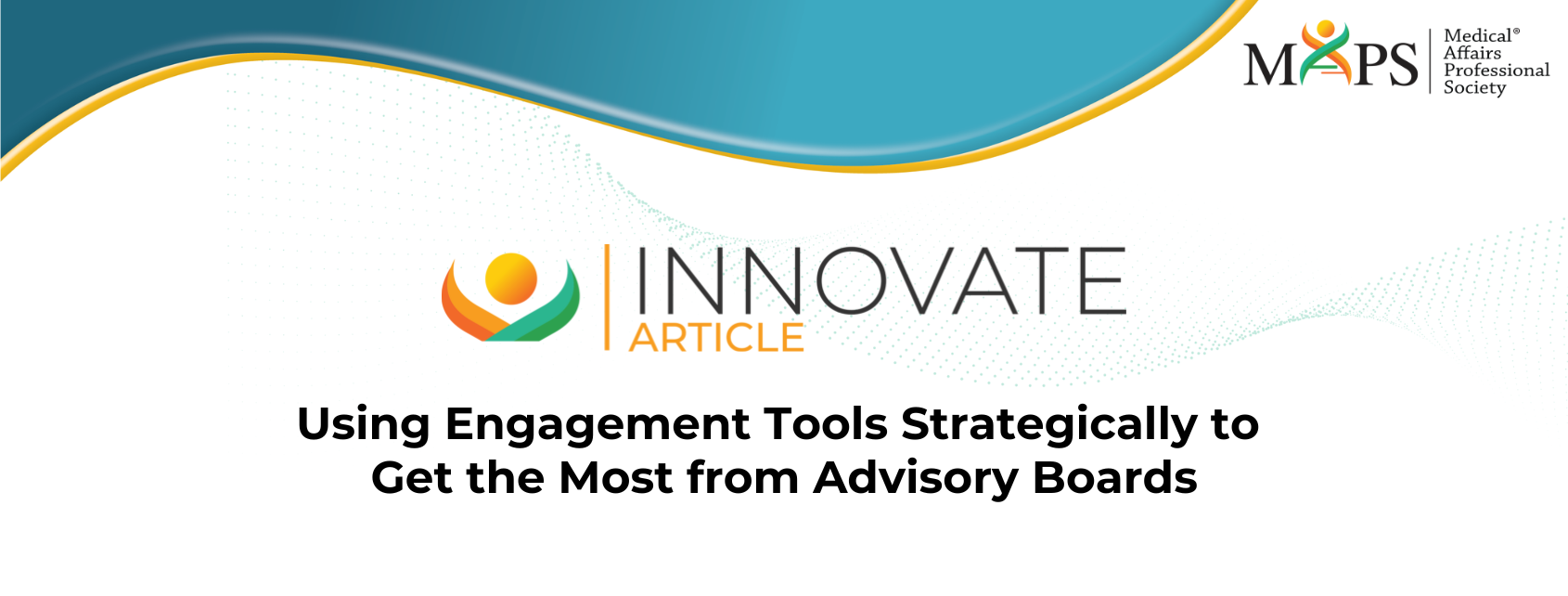Engagement means something different in an advisory board meeting than it does at a speaker training or investigator meeting. Unlike many life sciences meetings where imparting knowledge is the primary goal, both commercial and medical affairs advisory boards are designed to quickly and effectively engage advisors, gather valuable insights from them, and turn those insights into informed decisions. Rather than present content and ascertain the percentage of people in the room who retained it by the end of the meeting, organizers of advisory boards spur conversations and listen to answers. They also require confidentiality and, too often, these meetings lack opportunities to gather data for fear of losing confidentiality. There are, however, many ways to collect actionable insights from these meetings without compromising the company’s or advisors’ need for discretion. These can provide greater depth of information from the meeting and inform the company how to improve future advisory board meetings.

Chuck Levitan, Director of Business Development at Array
Advisory boards bring together a selection of key opinion leaders in health care to discuss a topic important to a life sciences company. A successful ad board encourages and facilitates open, honest dialogue among participants exposing new ideas, opinions, thoughts and concerns to the life sciences company. A successful meeting also will keep this information private. It is only shared back to the company by a designated scribe who provides an executive summary of what was said, why it was important, and other key takeaways.
These differ greatly from investigator meetings, medical education programs and the like, where the meeting organizer has important information to share with participants and needs to know it has been received. Engagement for these meeting types is designed to keep participants active, help them learn and retain key knowledge points, and gather data that can be used to determine successful educational impact. That doesn’t mean, though, that engagement tools have no place in an advisory board. Conversely, they can bring significant value to this type of meeting.
Engagement technology can help overcome the tendency for there to be dominant voices that overshadow others—and by doing so skew the conversation in one biased direction. In person, this can be accomplished by employing individualized technology such as managed iPads used by each attendee. Using the technology to enable polling, a question can be asked at the start of the program to gather opinions from every advisor on a topic. While there will be several people who share a like opinion, there will be those who answered quite differently. Rather than prompt discussion around the popular train of thought, give the attendees a specific amount of time (10 minutes, for example), to talk about this unique point of view. This is likely to bring you new insights and relevant ideas over your typical open unstructured discussion.
This type of technology also can be very effective at helping introverts and those not comfortable sharing what they think may be “irrelevant feedback”, “dumb questions,” or just “bad ideas.” Whereas other meeting types will commonly have an “Ask a Question” feature, advisory board technology could convert this functionality to “Solutions.” Present an idea, challenge, or concept to the group, and then ask all the advisors to type in and provide their ideas and solutions. Every participant is likely to share a unique thought since they aren’t being put on the spot by doing so. The moderator can see these in real-time, again directing the conversation to the points they think will bring about the most value.
Advisory board presentations also differ in that slides aren’t used to reinforce information as much as to initiate dialogue or reference documentation for a certain topic. Slides are not usually allowed to be saved or shared in this format, and there is no note-taking by participants. However, enabling advisors to interact with slides can bring additional value to the sponsor organization. Consider, for example, allowing them to “make a comment” or “provide feedback” rather than “take notes” on the slide. Maybe someone has a thought that hasn’t been fully fleshed out or that there wasn’t enough time for them to share during the live discussion. Since they were able to comment on slides, however, they wrote a “What if…?” or “But…” comment on a particular slide that provided new and interesting insight. That information would never have come to light without that extra layer of engagement.
The real benefit of engagement tools comes from including them in your meeting planning. Since ad boards are unique, it’s important to work with the technology provider early in the planning process to determine what topics you are most interested in gaining insight on, which engagement tools will help you best gather responses or generate additional conversation points, and what data you want to collect for final reporting. This last point is the ultimate benefit of using engagement tools in advisory boards (and every other life sciences meeting type for that matter). If implemented correctly by the technology provider, each engagement tool will gather useful individualized data from all attendees. What you will get at the end is not just an executive summary for a marketing team as provided by a scribe taking notes, but detailed data provided by the advisors themselves.
Consider the “make a comment” feature for slides. The marketing team will be able to look at all slides that had comments on them and see what one person said, or look at patterns to determine, for example, that most of the ad board had a similar concern about a topic raised on a slide. If this wasn’t discussed verbally during the meeting, this is information that could have gone unrealized. Engagement tools can collect each and every thought board members couldn’t share verbally. They can also provide insight into which participants were most active in presenting solutions, responding to the polling, and engaging with the content. Each and every “solution” the ad board provided in lieu of “ask a question” is recorded verbatim including those the moderator didn’t have time to discuss with the group.
Rather than considering engagement tools to be taboo in an ad board, it’s important to realize the added value they bring as the silent observer in the room.



